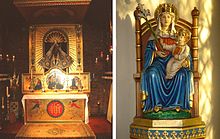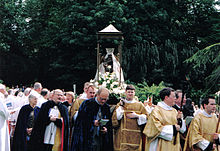Our Lady of Walsingham
Under the invocation of Our Lady of Walsingham (Our Lady of Walsingham) , the Virgin Mary from the 11th century - with an interruption from the 16th to the 19th century - in Walsingham , Norfolk , and beyond throughout England and the English-speaking world revered.
Apparition of Mary and medieval pilgrimage
The Anglo-Saxon noblewoman Richeldis is considered to be the founder of the pilgrimage site . The Blessed Mother appeared to her in a vision in 1061 , showed her the house of the Holy Family in Nazareth and commissioned her to rebuild this house in Norfolk. The new shrine in Walsingham became, after Canterbury , the second most important pilgrimage site in England, especially for those who could not afford a pilgrimage to the Holy Land, to Rome or to Santiago de Compostela. In 1150, an Augustinian canon monastery was founded next to the “Holy House” . In the High and Late Middle Ages numerous kings and queens from England and Scotland visited the place. In 1513 Erasmus came to Walsingham from Rotterdam and left an impressive description.
Destruction in the Reformation
After the English Church split from Rome by Henry VIII - who had come to Walsingham as a pilgrim himself - the Marian shrine and the collegiate church were destroyed in 1538. The miraculous image of Our Lady and other items of decoration were brought to London and burned.
Basilica of Our Lady of Walsingham
After Roman Catholic parishes and dioceses had re-established in England in the 19th century, the memory of Walsingham awoke. In 1896 the convert Charlotte Boyd bought the so-called Slipper Chapel. This was built in 1340 as the last pilgrimage chapel one and a half kilometers from Walsingham and has been converted and decayed since the Reformation. In 1897 Pope Leo XIII raised the parish church at King's Lynn , some 25 miles from Walsingham, to the Shrine of Notre Dame of Walsingham, and pilgrimages have resumed. On August 15, 1934, Cardinal Francis Bourne celebrated the first Holy Mass in the Slipper Chapel with 10,000 pilgrims and moved the sanctuary here ( 52 ° 52 ′ 52 ″ N , 0 ° 51 ′ 12 ″ E ). After the chapel was elevated to a minor basilica in 2015, it was named the Basilica of Our Lady of Walsingham .
On August 15, 1954, the new image of the Virgin created by Marcel Barbeau was solemnly crowned by the apostolic legate Gerald Patrick O'Hara , several thousand believers were present. This statue was also blessed by Pope John Paul II at Wembley in 1982 as part of his visit to England. In the same year, the Chapel of Reconciliation was built at the Slipper Chapel , which can hold 500 people and can be opened to the pilgrimage site for larger celebrations ( 52 ° 52 ′ 49.9 ″ N , 0 ° 51 ′ 9.5 ″ E ).
In 2004 the Communion of Notre Dame of Walsingham was founded, and in 2011 Pope Benedict XVI placed the Fellowship under its command . the new personal ordinariate for the Anglican converts to the Patronage of Our Lady of Walsingham. The main church of the North American staff ordinariate Kathedra Petri in Houston also has the patronage of Our Lady of Walsingham .
Anglican revival
In 1921 Alfred Hope-Patten became pastor of Walsingham and worked for the restoration of the sanctuary. In 1922 a statue of Our Lady of Walsingham was erected in the Anglican Parish Church and in 1923 the first pilgrimage took place. In 1931, the Marian shrine was rebuilt on the historical site as an Anglican pilgrimage site ( 52 ° 53 ′ 40.2 ″ N , 0 ° 52 ′ 26.2 ″ E ).
Individual evidence
- ↑ which St. Catherine was consecrated. The old name Slipper Chapel means something like "sandal chapel " in today's parlance and is associated with the custom of taking off your shoes here and walking the rest of the way to Walsingham in sandals or barefoot. The original meaning is more likely to have been "passage, access chapel ", namely to the holy district: Slipper Chapel (English) .
Web links
- Timetable (English)


